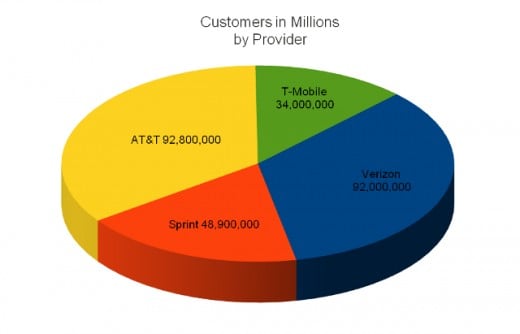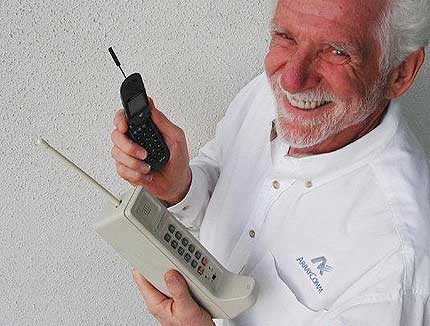The Sad State of Cellular Communications
Why the Author is Writing this Article
After writing about cell-phones, smart-phones, national coverage plans, pre-paid plans (and I still have a few more to cover), and "no contract" plans one thing has become glaringly obvious.
None of the plans I've covered to date are particularly economical. Some are downright excessive and the "no contract" plans, which indeed involve an agreement (contract), seem to be geared toward itemizing the consumer into the poor-house. Even pre-paid plans have their problems.
The Mobile Phone Necessity
They aren't really necessary when you think about it. It was only twenty-eight (28) years ago that the cell phone was only known to a select handful of people developing them. Before that if you were on the street and needed to contact someone you looked for a pay-phone or the kindness of a shop-owner who might let you use their phone. Not quite thirty (30) years ago that all began to change.
The author still has vivid memories of the first few times he thought the person standing next to me had flipped out, talking to themselves, only to realize a cell-phone was in hand and they were actually talking to someone else. Annoyance and relief were the two primary feelings had. Now he generally ignores anyone who appears to be talking to themselves, just out of habit.
In 2011 pay-phones are few and far between and it seems everywhere a person looks someone's cellphone/smartphone is being utilized to talk to someone else, text someone else, or the person down the street has one in hand as if it were a piece of jewelry.
As a profitable gadget the cellphone (smartphone) has changed fortunes, changed business and work habits, and modified the way people communicate with each other in their leisure time.
Mobile communications is big (very big) business and it's not going to go away.
But the current business models for mobile communications sales are limited to just three and the author's opinion is that none of them are all that economical or practical to the consumer.
What is most troubling about all of this is that cellular has reached maturity in a lot of ways. It's an older business now, and for that reason, most providers are well established. It's time for the prices charged to customers come down as the businesses settle and begin operating with a long term outlook.
Instead, some carriers are actually going to raise their rates this year. The exact opposite of what should be happening.
Near the end of this article the author will talk about Dr. Martin Cooper, inventor of the mobile-phone, and what his ideas are concerning the future of cellular communication.
Clearing the Air
Just for the sake of clarity the author would like to touch on something here that has everything to do with advertising and nothing at all to do with technology.
First generation phones were analog; anyone with the proper radio receiver could overhear your calls.
Second generations phones are/were digital.
Third generation phones are/were not only digital they support voice and data transmission at the same time. They also provide Internet access, video calling, and mobile TV and all at two hundred thousand bits per second.
Fourth generation phones and services DO NOT EXIST. They do not exist because the main specification for 4G is data transmission of one billion bits per second (1Gigabits/second) and no one has met that transmission speed in cellular communications. No one!
Prices Increases for 2011
Sprint, for one, just announced that starting January 30, 2011, rates for "unlimited" 3G plans will rise by $10 a month each. Ten dollars more per month when the infrastructure has largely stabilized and the phone offerings have actually come down in cost to manufacture.
With a two year contract this amounts to an additional $240.00.
The author would love to ask Dan Hesse, CEO of Sprint Communications, why the corporation feels their unchanged service and plans rate a price increase.
Worse, the author is almost certain that once Sprint raises their rates, rates for other carriers will rise as well. This is one of those situations, like airline travel, where one vendor raises rates or changes the rate structure and other's follow. Stay tuned because if that does happen you'll hear about it in this article.
Update
AT&T and Verizon announced plans to increase dollar amount for data downloads. Price changes for AT&T have been announced, but no dates set. Verizon's CEO has indicated rates need to go up, but was not more specific.

Plans
Contract Plans
The four big (and many smaller) cellular providers all expect the customer to sign a two year contract. The contract commits the consumer to a monthly payment, often at around seventy ($70) dollars, not including the price of the phone and the set-up fee.
There are a number of problems with this, not the least of which is the length of the contract itself. There is also the problem of being stuck with the same phone for two years (Sprint allows customers to upgrade after a year), like it or not. And then there's a cancellation fee of anywhere from $200 to $250. You have to surrender the phone too if you haven't had it that long.
"No Contract" Plans
These plans sell you a phone (separately), the minutes (separately), and want a $35.00 set-up fee. Even though these plans say "no contract" you are still committed to paying for your service month-to-month and if you want to discontinue the service you have to contact the vendor and say so. In other words you can't just stop paying for the service; so it's definitely a contract.
The problem with these plans is that the phone you get is the bare minimum required to make phone calls, you are billed for packages of minutes, have to pay a one-time fee for each set-up, and the phones themselves have so little battery power the whole concept becomes pointless.
Pre-Paid Plans
Beyond the fact that the phones offered on these plans are only slightly better than those offered on the "No Contract" plans, you are also "nickle-and-dimed" to the gills for accessories, overcharged for voice minutes, overcharged for texts (one charge for incoming and another charge for outgoing), and when you run out of minutes your phone stops working.
Commonalities
Regardless of the plan or the phone the following are problems regardless of which business model you end up on.
- Accessories are always extra and cost you well above a decent profit margin
- Cellular service is spotty no matter who you have
- Many phones just don't have a decent battery life
- Customer service sucks; some suck less than others, but CS is usually the biggest complaint
- You can't customize for only the features you want and need; it's all or nothing
- Usually the cell phone you buy from one provider will not work with another provider; you can't switch providers and keep the same phone
There Has to be a Better Way
It seems that at this point in time most, if not all, cellular providers concentrate more on generating profits for investors than focusing on value for the customer. Of course this makes sense, from the point of view of stock position and offerings.
Sooner or later these companies will become more mature and have to begin tipping the balance more toward value and less toward stellar profits for stockholders. This is a natural course of events. After all, there is nothing wrong with steady profits over decades rather than rocketing profits over the course of five or so years. Value oriented companies tend to be around far longer than these shooting stars.
Traitor to the Business Model
All it will take for this to happen is for one carrier to lower the price of the phone and/or carry a model that is highly customizable at low cost. Provide the consumer with only what they want or need and do it at (far) less than $600 per phone. This carrier will also be able to reduce the contract period because it will no longer need to be two years long to make up for the actual cost of the phone. Contracts could then be reduced to one year or less and early termination for cost less than $100.00. This would also spur the company or companies (should there be more than one) to offer incentives to consumers to stay with their current provider.
If that happens, and the author feels it's only a matter of time, "no contract" providers will no longer be viable.
Pre-paid will still have a place, but price per minute will likely need to drop and more incentives to stay with the pre-paid provider will be thought up. Pre-paid will then fall back to the four majors (AT&T, Sprint, T-Mobile, and Verizon) and the smaller companies that offer pre-paid will either disappear or find a better way to gain customers.
As it is, Verizon, Sprint, AT&T and T-Mobile all already offer pre-paid plans, but they are not well advertised and they are all (except possibly T-Mobile) considerably more expensive than companies like TracFone and Boost. To put this another way a pre-paid with any of these four is just as expensive, at least initially, as signing a contract.

Dr. Martin Cooper's Future Vision
Doctor Cooper lead the project team that created the first functional cellular phone. Even then it was a race between Bell Laboratories and the eventual winner Motorola. These are the issues with cellular communications as Dr. Cooper sees them.
The Problems
Most cellular calls are made indoors, but most cellular towers and base stations are outdoors. This accounts for a great number of dropped calls.
Cellular service is a closed system run by the provider with each provider using a different methodology for sending and receiving signals. This means there are multiple distinct networks that are not compatible with each other. This is the primary reason why a phone from one provider will not work with another provider. The user is "locked in" to the service by the phone as much as by the provider. This is not an accident.
Cellular signals are broadcast in a three dimensions in all directions even though most users are in a signal cone below the tower or base station. A lot of energy is wasted broadcasting to nowhere. This is energy that could be directed more effectively making calls more reliable and clearer.
Most of the cellular signal is used for voice communication yet providers continue to push the the idea that you need more band-width for data.
The phones are too disposable. A one year old model is "made" obsolete far before the end of the contract term.
Solutions
Antenna need to be better distributed indoors and out. This will cut down (drastically) on the number of dropped calls and provide the customer with better, more reliable service.
There should to be one standard for communications rather than four (or more). This will cut the expenditures each company is burdened with on transmission equipment and infrastructure, provide the user with a transferable phone, allow engineers to fine-tune the system, rather than spend so much time experimenting and tweaking a proprietary system, and open the market to everyone. As with the internet, an open system is the best system; for everyone.
Design the transmission towers and base stations so they concentrate the signal where it is needed rather than in every direction. This too will improve service. This is not an idea with no foundation; it is possible to do this right now.
Concentrate on what the consumer wants and needs rather than what the company wants the consumer to buy.
Make phones that are good for five to ten years rather than six to eight months. If necessary make phones that are user upgradable in both hardware and software by the owner.
Companies come up with products that are supposed to better serve customers. The wireless industry, on the other hand, decides what the consumer wants and builds systems to best serve the interests of the industry. - Martin Cooper
Verdict
The race to ever higher profit seems to be the driving force for cellular communications; not customer satisfaction.
The inevitable result will be increased customer dissatisfaction.
Despite the fact that our phones can do more and more and the features offered and provided encompass an ever expanding (and dizzying) galaxy of function, the voice call itself has not improved. In fact, if anything, the primary purpose of the phone, the voice call, seems to be no better or any more reliable than it was twenty years ago.
The question then is why hasn't the voice part of that equation improved? The answer is that providers are concentrating on multi-media and data transmission rather than on the quality of the voice signal.
What We Put up With
Our best calls are made from within our vehicles, but many states have now passed laws making talking and driving illegal. The phones, accessories, plans, and add-on gadgetry and software are largely overpriced. And the voice calls still, after all this time, have an echo chamber effect and distinctive lag. Both these problems should have been solved by now.
The essentials of the mobile phone have not improved, at all!
We really can't get by without them. The mobile phone has become as essential as food, water, and air. Yet, we the consumer, continue to endure high prices, poor reception, and atrocious customer service.
All three of these "sins" are unacceptable. It's time to grab the industry by the lapels, give it a good shaking, and ask it "what the heck are you thinking; give us what we need, not what you've decided we want."
It's time for the industry to wake-up, stop acting like a willful teen or pre-teen, and assume the role of adult.
Coda
The competition is fierce, but ultimately no one wins.
We pay too much, the companies futures hinge on the "latest thing" and the consumer ends up with mediocre service at best.
Because the life-span of the contracts and the phones are completely out of sync with each other, the consumer is constantly playing catchup. Even worse than that every cell phone made has a designed life-span of two years; then it's off to the garbage dump. All of this is by design too.
This results in customer dissatisfaction and eWaste.
Rather than concentrating on improving the quality of the call or providing a really good phone, most (if not all) providers are in an arms race of gadgetry and "wow" features. All of which drives profits and stock value.
Something has got to change.
Disclaimer
The author was not compensated in any way, monetarily, with discounts, or freebies by any of the companies mentioned.
Though the author does make a small profit for the word count of this article none of that comes directly from the manufacturers mentioned. The author also stands to make a small profit from advertising attached to this article.
The author has no control over either the advertising or the contents of those ads.








